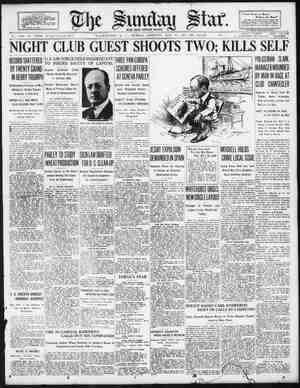Evening Star Newspaper, May 17, 1931, Page 82
You have reached the hourly page view limit. Unlock higher limit to our entire archive!
Subscribers enjoy higher page view limit, downloads, and exclusive features.
F 6 THE,_ SUNDAY STAR, WASHINGTON, D. C, MAY 17, 1931, - s — b Teaching Russia’s Hliterate Millions Going Back to Kindergarten Principles, the Whole Country Is Plastered With Big, Brightly Colored Cartoons That Put Over, Sovict Propaganda Against Alcohol, the Church, Uncleanliness and Wealth, W hile Radio Stories and Nezwspapers, Printed in Half-Inch Type Like a Child’s A B C’s, Help the Cause. BY R4LPH L. COSLER. to the Soviet government, its aims and s purposes. OVIET Rumia tofay &= undertaking the To understand this great poster campaign it greatest educational program ever at- is necessary to go back a littlc way in history. tempted by suy nathn—end is dolng When the Boisheviks took charge of the it by means of kindergarter principles in the Fall of 1917 they adapted for the use of adults. In Soviet Russia ther: are approxi- mately 60,000,000 illiterates—grown men and women who can neither read nor write. ~ The Ru:ssian government is determined to stamp out this illiteracy. It has to do this if it is to survive. The success of its vast Com- munistic program depends, in the long run, on the loyalty of the ordinary citizen. ‘This loyalty can only be held by means of propa- i, One of the posters used in promoting the five-year plan. The peasant woman is shown heading for the co-operative ferm, back by a kulak, a priest and her drunken husbund. and labor into the collective farms the govern- be so productive that the kulak cannot hope to ment would give them land to work and would compete with them. As a matter of fact, it furnish them with seeds, tractors and other may yet work out that way. machinery. In addiion, the government would build T is hard to tell just now how the collective farm idea 1is progressing. Government posters on display in Moscow claim 50 per cent of the peasants have already taken up collective farming, and assert that whereas they only ex- should to use them. "u!m g AR 5 pected- to have 57,000 collective farms by 1933, °°"'°‘lm el M"m ecplE: ry 5 July of 1930 saw them with more than 30,000— « another hdoltb:dmofa A‘“‘“ " : :fllufingmtthemmrumflmm both impressive and picturesque. On the other hand, it was reported thit 25 per cent- of the peasants left the collectives -én' ki ia “We could not chana?the psychology of theé Russian peasant in so short a time,” she said. spirited, however, are the posters against the kulak, visible in every these one must first under- the kulak is. revolution there was a considerable farmers who had lifted them- the Jovel of the average land-tiller, .+ 'They had enlarged sheir holdings, had obtained cattle and horses and had become comparatively rich. As a natural result, they did not,look at all favorably on the revolution, and they especially disliked the program for collectivized farms These comparatively well-to-do peasants were known as kulaks. When the revolution became successful and the theories of Karl Marx be- to be put imto practice the kulak got his lot became unpleasant. ,the Boviet leaders did all they ‘put collective farming into effect by ‘The kulak resisted mightily, with all of ‘the stiff fiflfiflfiv L1 HI8R BESHER “Let’s Smash the Kulak!” the inseription on this / Let's Smash Alcohol!” says this government n»yw.MMt&&“MM o v A - Soviet government makes and sells Nquov, but prope
